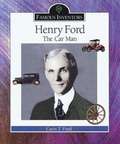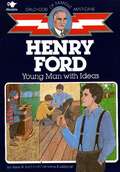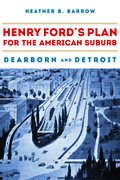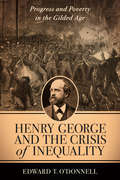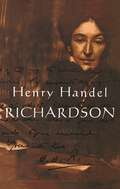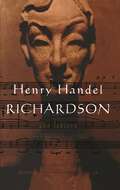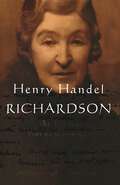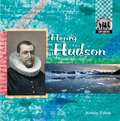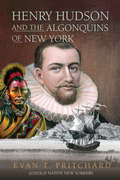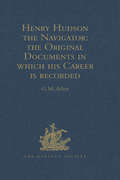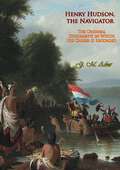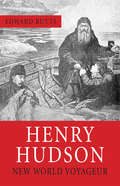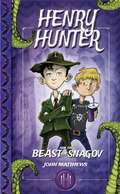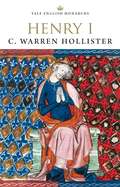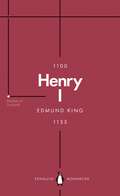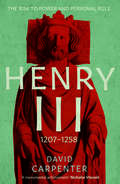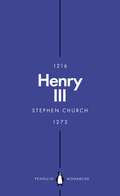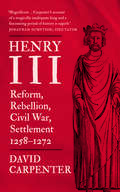- Table View
- List View
Henry Ford: The Car Man
by Carin T. FordA simple biography of the man who revolutionized American industry with his assembly-line production of automobiles.
Henry Ford: Young Man with Ideas (Childhood of Famous Americans Series)
by Hazel B. Aird Catherine RuddimanA fictionalized biography of the early life of the American automotive industrialist who founded the Ford Motor Company and pioneered in assembly-line methods of mass production.
Henry Ford’s Plan for the American Suburb: Dearborn and Detroit
by Heather BarrowAround Detroit, suburbanization was led by Henry Ford, who not only located a massive factory over the city's border in Dearborn, but also was the first industrialist to make the automobile a mass consumer item. So, suburbanization in the 1920s was spurred simultaneously by the migration of the automobile industry and the mobility of automobile users. A welfare capitalist, Ford was a leader on many fronts—he raised wages, increased leisure time, and transformed workers into consumers, and he was the most effective at making suburbs an intrinsic part of American life. The decade was dominated by this new political economy—also known as "Fordism"—linking mass production and consumption. The rise of Dearborn demonstrated that Fordism was connected to mass suburbanization as well. Ultimately, Dearborn proved to be a model that was repeated throughout the nation, as people of all classes relocated to suburbs, shifting away from central cities. Mass suburbanization was a national phenomenon. Yet the example of Detroit is an important baseline since the trend was more discernable there than elsewhere. Suburbanization, however, was never a simple matter of outlying communities growing in parallel with cities. Instead, resources were diverted from central cities as they were transferred to the suburbs. The example of the Detroit metropolis asks whether the mass suburbanization which originated there represented the "American dream," and if so, by whom and at what cost. This book will appeal to those interested in cities and suburbs, American studies, technology and society, political economy, working-class culture, welfare state systems, transportation, race relations, and business management.
Henry George and the Crisis of Inequality
by Edward O'DonnellThe remarkable explosion of American industrial output and national wealth at the end of the nineteenth century was matched by a troubling rise in poverty and worker unrest. As politicians and intellectuals fought over who to blame for this crisis, Henry George (1839--1897) published Progress and Poverty (1879), a radical critique of laissez-faire capitalism and its threat to the nation's republican traditions. His book, which became a surprise best-seller, offered a popular, provocative solution: a single-tax on land values. George's writings and years of social activism almost won him the mayor's seat in New York City in 1886. Though he lost the election, his ideas proved instrumental to shaping a progressivism that remains essential to tackling inequality today.Edward T. O'Donnell's exploration of George's life and times merges labor, ethnic, intellectual, and political history to illuminate the early militant labor movement in Gilded Age New York. O'Donnell locates in George's rise to prominence the beginning of a larger effort by American workers to regain control of the workplace and obtain economic security. The Gilded Age was the first but by no means last period in which Americans confronted the mixed outcomes of modern capitalism. George's accessible, forward-thinking ideas on democracy, equality, and freedom have tremendous value to ongoing debates over the future of unions, corporate power, Wall Street recklessness, regulation, and political polarization.
Henry George and the Crisis of Inequality: Progress and Poverty in the Gilded Age (Columbia History of Urban Life)
by Edward O'DonnellAmerica's remarkable explosion of industrial output and national wealth at the end of the nineteenth century was matched by a troubling rise in poverty and worker unrest. As politicians and intellectuals fought over the causes of this crisis, Henry George (1839–1897) published a radical critique of laissez-faire capitalism and its threat to the nation's republican traditions. Progress and Poverty (1879), which became a surprise best-seller, offered a provocative solution for preserving these traditions while preventing the amassing of wealth in the hands of the few: a single tax on land values. George's writings and years of social activism almost won him the mayor's seat in New York City in 1886. Though he lost the election, his ideas proved instrumental to shaping a popular progressivism that remains essential to tackling inequality today.Edward T. O'Donnell's exploration of George's life and times merges labor, ethnic, intellectual, and political history to illuminate the early militant labor movement in New York during the Gilded Age. He locates in George's rise to prominence the beginning of a larger effort by American workers to regain control of the workplace and obtain economic security and opportunity. The Gilded Age was the first but by no means the last era in which Americans confronted the mixed outcomes of modern capitalism. George's accessible, forward-thinking ideas on democracy, equality, and freedom have tremendous value for contemporary debates over the future of unions, corporate power, Wall Street recklessness, government regulation, and political polarization.
Henry Handel Richardson Vol 1: 1874-1915
by Probyn, Clive Steele, BruceThis three volume set marks the first time any Australian literary writer has had his/her correspondence published in its entirety. The letters of Henry Handel Richardson were opened in March 1996 to unrestricted access, but none of the letters may be published until this edition of the complete correspondence has been released. At present, there are approximately 1800 unpublished manuscript letters to and from HHR, which form a correspondence between Australia, England, German, Italy and the USA for the period 1874 to 1946. The letters shed much new light on HHR's biography, her artistic methods, her personal life, her friendships (and antagonisms), her response to Australian readers and to expatriation, and her efforts to maintain a literary life apart from her personal life. They include HHR's earliest letter, and trace her student days in Leipzig, the publication of Maurice Guest, The Getting of Wisdom, The Fortunes of Richard Mahoney, The End of a Childhood, and The Young Cosima, and her experience of life in wartime England. Some of the most vivid letters describe her schooldays (the biographical context for The Getting of Wisdom), her memories of the Australian bush, her relationship with Vance and Nettie Palmer, her meetings with Miles Franklin and her views on contemporary writing. The letters to Mary Kernot provide constant linkages between life in England and Australia during the most formative period for modern Australian literature (including the negotiations for HHR's Nobel Prize nomination).
Henry Handel Richardson Vol 2: 1917-1933
by Edited By SteeleThe publication of Henry Handel Richardson's correspondence will be a major event in Australian scholarly publishing. It will be the first time any Australian literary writer has had his/her correspondence published in its entirety. The letters of Henry Handel Richardson - deposited in the National Library of Australia in Canberra and in the Mitchell Library in Sydney - were opened in March 1996 to unrestricted access, after a fifty-year period of closed access. The executrix of the HHR estate has determined, however, that none of the letters may be published in whole or in part until after Probyn and Steele's edition of the complete correspondence has been released. At present, there are approximately 1800 unpublished manuscript letters to and from HHR, of which at least 1000 are in her own hand. They form a correspondence between Australia, England, German, Italy and the USA for the period 1874 to 1946. Within the total number there are two quite distinct and major sub-groups, the first (1910 - 14) being a collection of both sides of the correspondence between HHR and the French translator of Maurice Guest, Paul Solanges; the second (1911 - 46) letters between HHR and Mary A. Kernot of Melbourne. As well as the letters held in the National and Mitchell libraries, the editors possess an entire sequence of letters from William Heinemann to HHR and her husband John George Robertson detailing the publication history of Ultima Thule, the final volume of The Fortunes of Richard Mahoney, the trilogy which cemented her international reputation. They are adding to the collection almost monthly, but have reason to believe that about 90% of the extant letters are now in their possession. The letters, as might be expected, shed much new light on HHR's biography, her artistic methods, her personal life, her friendships (and antagonisms), her response to Australian readers and to expatriation, and her efforts to maintain a literary life apart from her personal life. The series includes HHR's earliest letter, her student days in Leipzig, the publication of Maurice Guest, The Getting of Wisdom, The Fortunes of Richard Mahoney, The End of a Childhood, and The Young Cosima, and her experience of life in wartime England. Some of the most vivid letters describe her schooldays (the biographical context for The Getting of Wisdom), her memories of the Australian bush, her relationship with Vance and Nettie Palmer, her meetings with Miles Franklin, her views on contemporary writing, and life in wartime England. In particular, the letters to and from Solanges are packed with information about the writing, the autobiographical roots and the meaning of Maurice Guest. The letters to Kernot provide constant linkages between life in England and Australia during the most formative period for modern Australian literature (including the negotiations for HHR's Nobel Prize nomination).
Henry Handel Richardson Vol 3: 1934-1946
by Edited By SteeleThe publication of Henry Handel Richardson's correspondence is a major event in Australian scholarly publishing. There are approximately fifteen hundred unpublished manuscript letters to and from HHR, of which almost a thousand are in her own hand. They form a correspondence between Australia, England, Germany, Italy and the USA over a seventy-year period, 1874 to 1946. The letters shed new light on Henry Handel Richardson's biography, her artistic methods, her personal life, her friendships (and antagonisms), her response to Australian readers and to expatriation, and her rigorous efforts to maintain a literary life apart from her personal life. The collection begins with HHR's earliest letter, then traces her student days in Leipzig, the publication of Maurice Guest, The Getting of Wisdom, The Fortunes of Richard Mahony, The Young Cosima and The End of a Childhood, and her struggle late in life with the stringencies of wartime England. In this volume the widowed HHR moves to the Sussex village where she lived until her death. The letters cover the publication of The End of a Childhood and Other Stories, the ill-fated The Young Cosima and her incomplete memoir Myself When Young. War dominated the closing years of her life, and she reported her experiences graphically to Mary Kernot. She refused to leave her house, even while the Battle of Britain was being fought in the skies above her. The strain and deprivations of war weakened her. When unable to write, her companion and secretary Olga Roncoroni wrote for her, and these letters are included. Her last letter is a little pencilled note to Mary Kernot.
Henry Hudson
by Kristin PetrieThis biography introduces young readers to the life of Englishman Henry Hudson. Readers learn that Hudson's grandfather helped form the Muscovy Company and that Hudson himself later sailed for the Muscovy Company, trying to find a passage to Asia through the North Pole. Hudson's family life and work as a cabin boy are also discussed, as well as his voyage with John Davis to the Canadian Arctic. Through engaging text, readers learn that Hudson's goal was to find a shorter route from Europe to Asia through the Arctic Ocean. His attempts to find a northwest passage to Asia while working for the Dutch East India Company and the British East India Company are explained. Readers also discover that on his final voyage, Hudson was the victim of a mutiny and left to die in the Hudson Bay. The book explains that Hudson's discoveries led to Dutch and English colonization of North America and that today a strait, a bay, and a river are named after Hudson. The book also introduces the idea that Hudson's North American discoveries led other explorers to discover a Northwest Passage.
Henry Hudson and the Algonquins of New York: Native American Prophecy & European Discovery, 1609
by Evan T. PritchardIn 2009, New York observed the 400-year anniversary of Henry Hudson's September 1609 discovery of Manhattan Island. This book chronicles the event from the perspective of the people who met Hudson's boat—which they at first thought was surely a great waterfowl—floating. Using all available sources, including oral history passed down to today's Algonquins, Evan Pritchard tells the story from various perspectives: that of Hudson's body guard, scribe, and personal Judas, Robert Juet; that of Hudson himself; and that of the Eastern Algonquins who greeted Hudson as the fulfillment of ancient prophecies.
Henry Hudson the Navigator: The Original Documents in which his Career is Recorded (Hakluyt Society, First Series)
by G. M. Asher'Collected, partly Translated, and Annotated, with an Introduction'. The supplementary material includes the 1860 annual report. This is a new print-on-demand hardback edition of the volume first published in 1860.
Henry Hudson, the Navigator: The Original Documents in Which His Career Is Recorded
by G. M. Asher“Four centuries ago, English explorer Henry Hudson (1570-1611), commanding the yacht ‘Halve Maen’ for the Dutch East India Company, sailed into a New World tidal estuary near the landmass the local Lenape Indians called the "island of many hills." The island was Manhattan, and though Hudson was unlikely the first European to see the river, it has been forever after that known by his name. This classic 1860 work collects the eyewitness documentation of Hudson's voyages of exploration, edited, partially translated, and annotated by GEORG MICHAEL ASHER (d. 1905). This invaluable volume of historical accounts includes abstracts of Hudson's own journals, reports by other sailors under Hudson's command, extracts from commentary by Hudson's contemporaries, and much more. The best record we have of Henry Hudson's achievements, this replica volume will be prized by fans of firsthand history.”-Print ed.
Henry Hudson: New World Voyager
by Edward ButtsIn 1607 Henry Hudson was an obscure English sea captain. By 1610 he was an internationally renowned explorer. He made two voyages in search of a Northeast Passage to the Orient and had discovered the Spitzbergen Islands and their valuable whaling grounds. In the process, Hudson had sailed farther north than any other European before him. In 1609, working for the Dutch, he had explored the Hudson River and had made a Dutch colony in America possible. Sailing from England in 1610, on what would be his most famous voyage, Hudson began his search for the Northwest Passage through the Canadian Arctic. This was also his last exploration. Only a few of the men under his command lived to see England again. Hudson’s expedition was one of great discovery and even greater disaster. Extreme Arctic conditions and Hudson’s own questionable leadership resulted in the most infamous mutiny in Canadian history, and a mystery that remains unsolved.
Henry Hunter and the Beast of Snagov: Henry Hunter Series #1 (Henry Hunter Series #1)
by John MatthewsAdolphus Pringle lived a relatively normal life before he met Henry Hunter, but being the best friend of a twelve-year-old millionaire genius certainly makes life interesting. He has accompanied Henry on adventures all over the world and encountered dozens of supernatural creatures. Henry has a penchant for paranormal mysteries, and he never fails to drag his trusty sidekick, Dolf, into adventures to track down the truth in these mystical legends.Henry announces one morning that he and Dolf are going to go in search of a creature more terrifying than Dracula himself: the Beast of Snagov. The pair of supernatural investigators travel from where Bram Stoker stayed in Whitby to Transylvania. Along the way they come across some strange things such as Dracula’s daughter, Bella, and an organization called the Order of the Dragon that wants to sacrifice Henry Hunter to the Beast of Snagov. When Henry is taken, it’s up to Dolf and Bella to team up and rescue him!Will Henry survive this supernatural adventure? Get ready to discover the world of the supernatural through the eyes of our spooked narrator as he tags along on the first adventure in the Henry Hunter series!Sky Pony Press, with our Good Books, Racehorse and Arcade imprints, is proud to publish a broad range of books for young readers-picture books for small children, chapter books, books for middle grade readers, and novels for young adults. Our list includes bestsellers for children who love to play Minecraft; stories told with LEGO bricks; books that teach lessons about tolerance, patience, and the environment, and much more. While not every title we publish becomes a New York Times bestseller or a national bestseller, we are committed to books on subjects that are sometimes overlooked and to authors whose work might not otherwise find a home.
Henry I
by Dr Amanda Clark Frost C. Warren HollisterHenry I, son of William the Conqueror, ruled from 1100 to 1135, a time of fundamental change in the Anglo-Norman world. This long-awaited biography, written by one of the most distinguished medievalists of his generation, offers a major reassessment of Henry's character and reign. Challenging the dark and dated portrait of the king as brutal, greedy, and repressive, it argues instead that Henry's rule was based on reason and order.C. Warren Hollister points out that Henry laid the foundations for judicial and financial institutions usually attributed to his grandson, Henry II. Royal government was centralized and systematized, leading to firm, stable, and peaceful rule for his subjects in both England and Normandy. By mid-reign Henry I was the most powerful king in Western Europe, and with astute diplomacy, an intelligence network, and strategic marriages of his children (legitimate and illegitimate), he was able to undermine the various coalitions mounted against him. Henry strove throughout his reign to solidify the Anglo-Norman dynasty, and his marriage linked the Normans to the Old English line.Hollister vividly describes Henry's life and reign, places them against the political background of the time, and provides analytical studies of the king and his magnates, the royal administration, and relations between king and church. The resulting volume is one that will be welcomed by students and general readers alike.
Henry I: The Father of His People (Penguin Monarchs)
by Edmund King'To be a medieval king was a job of work ... This was a man who knew how to run a complex organization. He was England's CEO'The youngest of William the Conqueror's sons, Henry I came to unchallenged power only after two of his brothers died in strange hunting accidents and he had imprisoned the other. He was destined to become one of the greatest of all medieval monarchs, both through his own ruthlessness, and through his dynastic legacy. Edmund King's engrossing portrait shows a strikingly charismatic, intelligent and fortunate man, whose rule was looked back on as the real post-conquest founding of England as a new realm: wealthy, stable, bureaucratised and self-confident.
Henry II: A Prince Among Princes (Penguin Monarchs)
by Richard BarberHenry II (1154-89) through a series of astonishing dynastic coups became the ruler of an enormous European empire. One of the most dynamic, restless and clever men ever to rule England, he was brought down both by his catastrophic relationship with his archbishop Thomas Becket and his debilitating arguments with his sons, most importantly the future Richard I and King John. His empire may have ultimately collapsed, but in Richard Barber's vivid and sympathetic account the reader can see why Henry II left such a compelling impression on his contemporaries.
Henry III: 1207-1258
by David CarpenterThe first in a ground-breaking two-volume history of Henry III’s rule, from when he first assumed the crown to the moment his personal rule ended Nine years of age when he came to the throne in 1216, Henry III had to rule within the limits set by the establishment of Magna Carta and the emergence of parliament. Pacific, conciliatory, and deeply religious, Henry brought many years of peace to England and rebuilt Westminster Abbey in honor of his patron saint, Edward the Confessor. He poured money into embellishing his palaces and creating a magnificent court. Yet this investment in "soft power" did not prevent a great revolution in 1258, led by Simon de Montfort, ending Henry's personal rule. Eminent historian David Carpenter brings to life Henry's character and reign as never before. Using source material of unparalleled richness—material that makes it possible to get closer to Henry than any other medieval monarch—Carpenter stresses the king’s achievements as well as his failures while offering an entirely new perspective on the intimate connections between medieval politics and religion.
Henry III: A Simple and God-Fearing King (Penguin Monarchs)
by Stephen ChurchHenry III was a medieval king whose long reign continues to have a profound impact on us today. He was on the throne for 56 years and during this time England was transformed from being the private play-thing of a French speaking dynasty into a medieval state in which the king answered for his actions to an English parliament, which emerged during Henry's lifetime. Despite Henry's central importance for the birth of parliament and the development of a state recognisably modern in many of its institutions, it is Henry's most vociferous opponent, Simon de Montfort, who is in many ways more famous than the monarch himself. Henry is principally known today as the driving force behind the building of Westminster Abbey, but he deserves to be better understood for many reasons - as Stephen Church's sparkling account makes clear.Part of the Penguin Monarchs series: short, fresh, expert accounts of England's rulers in a highly collectible format
Henry III: Reform, Rebellion, Civil War, Settlement, 1258-1272 (The English Monarchs Series #2)
by David CarpenterThe second volume in the definitive history of Henry III’s rule, covering the revolutionary events between 1258 and the king’s death in 1272 After coming to the throne aged just nine, Henry III spent much of his reign peaceably. Conciliatory and deeply religious, he created a magnificent court, rebuilt Westminster Abbey, and invested in soft power. Then, in 1258, the king faced a great revolution. Led by Simon de Montfort, the uprising stripped him of his authority and brought decades of personal rule to a catastrophic end. In the brutal civil war that followed, the political community was torn apart in a way unseen again until Cromwell. Renowned historian David Carpenter brings to life the dramatic events in the last phase of Henry III’s momentous reign. Carpenter provides a fresh account of the king’s strenuous efforts to recover power and sheds new light on the characters of the rebel de Montfort, Queen Eleanor, and Lord Edward—the future Edward I. A groundbreaking biography, Henry III illuminates as never before the political twists and turns of the day, showing how politics and religion were intimately connected.
Henry III: The Great King England Never Knew It Had
by Darren Baker‘Henry III is generally classed among the weakest and most incompetent of England’s medieval kings. Darren Baker tells a different story.’- Michael Clanchy, author of England and Its Rulers, 1066–1307 ‘A personal and detailed narrative…bring[s] alive the glamour and personalities of thirteenth-century England.’- Huw Ridgeway, author of ‘Henry III’, Oxford Dictionary of National Biography ‘Enterprising, original and engaging’ - David Carpenter, author of The Reign of King Henry III Henry III (1207–72) reigned for 56 years, the longest-serving English monarch until the modern era. Although knighted by William Marshal, he was no warrior king like his uncle Richard the Lionheart. He preferred to feed the poor to making war and would rather spend time with his wife and children than dally with mistresses and lord over roundtables. He sought to replace the dull projection of power imported by his Norman predecessors with a more humane and open-hearted monarchy. But his ambition led him to embark on bold foreign policy initiatives to win back the lands and prestige lost by his father King John. This set him at odds with his increasingly insular barons and clergy, now emboldened by the protections of Magna Carta. In one of the great political duels of history, Henry struggled to retain the power and authority of the crown against radical reformers like Simon de Montfort. He emerged victorious, but at a cost both to the kingdom and his reputation among historians. Yet his long rule also saw extraordinary advancements in politics and the arts, from the rise of the parliamentary state and universities to the great cathedrals of the land, including Henry’s own enduring achievement, Westminster Abbey.
Henry IV
by Chris Given-WilsonHenry IV (1399-1413), the son of John of Gaunt, duke of Lancaster, seized the English throne at the age of thirty-two from his cousin Richard II and held it until his death, aged forty-five, when he was succeeded by his son, Henry V. This comprehensive and nuanced biography restores to his rightful place a king often overlooked in favor of his illustrious progeny. Henry faced the usual problems of usurpers: foreign wars, rebellions, and plots, as well as the ambitions and demands of the Lancastrian retainers who had helped him win the throne. By 1406 his rule was broadly established, and although he became ill shortly after this and never fully recovered, he retained ultimate power until his death. Using a wide variety of previously untapped archival materials, Chris Given-Wilson reveals a cultured, extravagant, and skeptical monarch who crushed opposition ruthlessly but never quite succeeded in satisfying the expectations of his own supporters. "
Henry IV, Part I: A History
by William ShakespeareAfter overthrowing his predecessor, King Henry IV is acutely aware of the delicate political tensions he must balance to protect his throne. On one hand, he must rein in his son, the mischievous Prince Hal, who has left the court for a life of drinking and pleasure. At the same time, he must put down a rebellion of some of the most powerful families in England. Henry IV, Part I is the second of four connected plays about successive British monarchs, including Richard II, Henry IV, Part II, and Henry V.
Henry IV, Part II: A History
by William ShakespeareAfter defeat at the Battle of Shrewsbury the rebels regroup. But Prince Hal’s reluctance to inherit the crown threatens to destroy the ailing Henry IV’s dream of a lasting dynasty. Shakespeare’s portrait of the prodigal son’s journey from youth to maturity embraces the full panorama of society. Henry IV, Part 2 is believed to have been written between 1596 and 1599. It is the third part of a tetralogy, preceded by Richard II and Henry IV, Part 1 and succeeded by Henry V.
Henry IV: King of France (Routledge Revivals)
by David BuisseretFirst published in 1984, Henry IV describes and tries to account for Henry’s extraordinary life and reign. The book is accompanied, and the arguments are strengthened by numerous plates and maps.The life of Henry IV of France was not only dramatic, but it also made a profound difference to the shaping of France in the early 17th century. During his reign, the foundations of the ‘grand siècle’ were laid, not only in military and diplomatic affairs, but also in the arts.Almost as striking as the personal contribution made by the king, is the remarkable willingness of the French nobility to wreck the whole recovery from forty years of domestic chaos by plotting with the Spaniards. Eventually, of course, one of these plots succeeded; Henry was killed, and the kingdom was plunged for a while into chaos. This book is a must read for students and researchers of French history.
